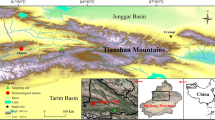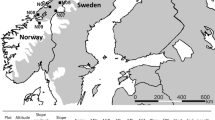Abstract
Key message
Pinus cembroides exhibits an excellent potential for dendrochronological studies on the basis of statistical parameters and its response to climatic variables, in particular seasonal winter–spring precipitation.
Abstract
Studies of forest growth under induced climatic variations allow estimating the intensity of impacts on forest ecosystems and understanding them. In the present study, the climatic response of Pinus cembroides radial increase was evaluated based on precipitation and average temperature (maximum, minimum and mean temperature). The study was carried out in Sierra del Cubo, Guanajuato, in the upper course of the Laja River. A correlation response function analysis was used to evaluate P. cembroides growth in response to climatic factors. Correlation analysis indicates that P. cembroides growth is positively associated with precipitation of October and December of the previous year, as well as with January–February, May–August and October of the current-year precipitation. Regarding temperatures, the average minimum temperature of the previous December and of January and May of the current year favored P. cembroides growth. Mean and maximum average temperature had a negative influence on annual radial growth. Response function analysis indicates that P. cembroides response to precipitation was quite unstable for the 1925–2011 period and possibly affected by climatic anomalies recorded over the last decades. The main climatic factors exerting a dominant effect on P. cembroides radial growth are, first, the winter–spring seasonal rainfall and, second, the average winter temperature. P. cembroides forests in Sierra del Cubo are highly affected by environmental variables, and its habitat could decline if winters tend to be drier and temperatures are higher as it is predicted to occur by Intergovernmental Panel of Climate Change models.











Similar content being viewed by others
References
Allen CD, Macalady A, Chenchouni H, Bachelet D, McDowell N, Vennetier M, Kitzberger T, Rigling A, Breshears D, Hogg EH, Gonzalez P, Fensham R, Zhang Z, Castro J, Demidova N, Lim JH, Allard G, Running S, Semerci A, Cobb N (2010) A global overview of drought and heat-induced tree mortality reveals emerging climate change risks for forests. Forest Ecol Manag 259:660–684. https://doi.org/10.1016/j.foreco.2009.09.001
Astudillo-Sánchez CC, Villanueva-Díaz J, Endara-Agramont R, Nava-Bernal G (2017) Climatic variability at the treeline of the Monte Tlaloc, Mexico: a dendrochronological approach. Trees 31:441–453. https://doi.org/10.1007/s00468-016-1460-z
Beniston M, Innes JL (1998) Impacts of climatic variability and extreme on forests: synthesis. In: Beniston PM, Innes DJL (eds) The impacts of climate variability on forests. Lecture notes in Earth Sciences. Springer, Berlin, pp 309–318
Breshears DD, Cobb NS, Rich PM, Price KP, Allen CD, Balice RG, Romme WH, Kastens JH, Floyd ML, Belnap J, Anderson JJ, Myers OB, Meyer CW (2005) Regional vegetation die-off in response to global-change-type drought. PNAS 102:15144–15148. https://doi.org/10.1073/pnas.0505734102
Briffa KR (1999) Interpreting high-resolution proxy climate data-the example of dendroclimatology. In: Storch PH, von Navarra DA (eds) Analysis of climate variability. Springer, Berlin, pp 77–94
Briffa KR, Osborn TJ, Schweingruber FH (2004) Large-scale temperature inferences from tree rings: a review. Glob Planet Chang 40:11–26. https://doi.org/10.1016/S0921-8181(03)00095-X
Bunn AG (2008) A dendrochronology program library in R (dplR). Dendrochronologia 26:115–124. https://doi.org/10.1016/j.dendro.2008.01.002
Cardoza MF, Cerano Paredes J, Villanueva Díaz J, Cervantes Martínez R, Guerra de la Cruz V, Estrada Ávalos J (2014) Reconstrucción de la precipitación anual para la región oriental del Estado de Tlaxcala. Rev mex de cienc Forestales 5:110–127. http://www.scielo.org.mx/scielo.php?script=sci_arttext&pid=S2007-11322014000300009. Accessed 16 Jun 2017
Carlón Allende T, Mendoza M, Pérez-Salicrup D, Villanueva-Díaz J, Lara A (2016) Climatic responses of Pinus pseudostrobus and Abies religiosa in the Monarch Butterfly Biosphere Reserve, Central Mexico. Dendrochronologia 38:103–116. https://doi.org/10.1016/j.dendro.2016.04.002
Carlón-Allende T, Mendoza M, Villanueva-Díaz J, Pérez-Salicrup D (2015) Análisis espacial del paisaje como base para muestreos dendrocronológicos: El caso de la Reserva de la Biosfera Mariposa Monarca, México. Madera y Bosques 2:11–22. http://www.scielo.org.mx/scielo.php?script=sci_arttext&pid=S1405-04712015000200001. Accessed 15 Jul 2017
Carnicer J, Coll M, Ninyerola M, Pons X, Sánchez G, Peñuelas J (2011) Widespread crown condition decline, food web disruption, and amplified tree mortality with increased climate change-type drought. PNAS 108:1474–1478. https://doi.org/10.1073/pnas.1010070108
Cerano PJ, Villanueva-Díaz J, Cerantes MR, Vázquez SL, Trucios CR, Guerra de la Cruz V (2013) Reconstrucción de precipitación invierno-primavera para el Parque Nacional Pico de Tancítaro, Michoacán. Invest Geogr 83:41–54. https://doi.org/10.14350/rig.35190
Cleaveland MK, Stahle DW, Therrell MD, Villanueva-Díaz J, Burns BT (2003) Tree-ring reconstructed winter precipitation and tropical teleconnections in Durango, Mexico. Clim Chang 59:369–388. https://doi.org/10.1023/A:1024835630188
Constante García V, Villanueva Díaz J, Cerano Paredes J, Oviedo C, Valencia Manzo S (2009) Dendrocronología de Pinus cembroides Zucc. y reconstrucción de precipitación estacional para el Sureste de Coahuila. Rev Cien For Mex 34:17–39. http://www.scielo.org.mx/scielo.php?script=sci_arttext&pid=S1405-35862009000200002. Accessed 17 Aug 2017
Cortés B, Nayeli E, Villanueva Díaz J, Nieto de Pascual PC, Estrada Ávalos J, Guerra de la Cruz V (2012) Reconstrucción de precipitación estacional para el noroeste de Guanajuato. Rev mex de Cienc Forestales 3:51–67. http://www.scielo.org.mx/scielo.php?script=sci_arttext&pid=S2007-11322012000100005. Accessed 15 Jul 2017
D’Arrigo R, Wilson R, Liepert B, Cherubini P (2008) On the ‘Divergence Problem’ in Northern Forests: a review of the tree-ring evidence and possible causes. Glob Planet Chang 60:289–305. https://doi.org/10.1016/j.gloplacha.2007.03.004
Easterling DR, Evans JL, Groisman PY, Karl TR, Kunkel KE, Ambenje P (2000a) Observed variability and trends in extreme climate events: a brief review. BAMS 81: 417–425. https://doi.org/10.1175/1520-0477(2000)081<0417:OVATIE>2.3.CO;2
Easterling DR, Meehl GA, Parmesan C, Changnon SA, Karl TR, Mearns LO (2000b) Climate extremes: observations, modeling, and impacts. Science 289:2068–2074. https://doi.org/10.1126/science.289.5487.2068
Englehart PJ, Douglas AV (2005) Changing behavior in the diurnal range of surface air temperatures over Mexico. Geophys Res Lett 32:L01701. https://doi.org/10.1029/2004GL021139
Floyd (2003) Ancient Piñon–Juniper Woodlands: a natural nistory of Mesa Verde country. University Press of Colorado, Boulder
Fritts H (2001) Tree rings and climate. Blackburn, Caldwell
Hanson PJ, Weltzin JF (2000) Drought disturbance from climate change: response of United States forests. Sci Total Environ 262:205–220. https://doi.org/10.1016/S0048-9697(00)00523-4
Holmes RL (1983) Computer-assisted quality control in tree-ring dating and measurement. Tree-Ring Bulletin 43:69–78. http://hdl.handle.net/10150/261223. Accessed 15 Jul 2017
Hughes MK (2011) Dendroclimatology in high-resolution Paleoclimatology. In: Hughes MK, Swetnam TW, Diaz HF (eds) Dendroclimatology, developments in paleoenvironmental research. Springer, Netherlands, pp 17–34
Linares JC, Camarero JJ, Carreira JA (2009) Interacting effects of changes in climate and forest cover on mortality and growth of the southernmost European fir forests. Glob Ecol Biogeogr 18:485–497. https://doi.org/10.1111/j.1466-8238.2009.00465.x
Luna-Cavazos M, Romero-Manzanares A, García-Moya E (2008) Afinidades en la flora genérica de piñonares del norte y centro de México: un análisis fenético. Rev Mex Biodiv 79:449–458. http://www.scielo.org.mx/scielo.php?script=sci_arttext&pid=S1870-34532008000200019. Accessed 20 Nov 2017
Meko DM, Touchan R, Díaz JV, Griffin D, Woodhouse CA, Castro CL, Carillo C, Leavitt SW (2013) Sierra San Pedro Mártir, Baja California, cool-season precipitation reconstructed from earlywood width of Abies concolor tree rings. JGR Biogeosci 118:1660–1673. https://doi.org/10.1002/2013JG002408
Mendoza ME, Bocco G, Bravo M, López-Granados E, Osterkamp WR (2006) Predicting water surface fluctuation of continental lakes. A GIS and RS based approach in Central Mexico. Water Resour Manage 20(2):291–311. https://doi.org/10.1007/s11269-006-8199-z
Molnár P, Ramírez, J (2001) Recent trends in precipitation and streamflow in the Rio Puerco Basin. Journal of Climate 14 (10):2317–2328. https://doi.org/10.1175/1520-0442(2001)014<2317:RTIPAS>2.0.CO;2
Paulhus JLH, Kohler MA (1952) Interpolation of missing precipitation records. AMS 80:129–133. https://doi.org/10.1175/1520-0493(1952)080<0129:IOMPR>2.0.CO;2
Robinson WJ, Evans R (1980) A microcomputer-based tree-ring measuring system. Tree Ring Bull 40:59–64. http://hdl.handle.net/10150/260443. Accessed 15 Jul 2017
Romero A, Luna M, García E (2014) Factores físicos que influyen en las relaciones florísticas de los piñonares (Pinaceae) de San Luis Potosí, México. Rev Biol Trop 2:795–808. http://www.redalyc.org/resumen.oa?id=44931383032. Accessed 14 Apr 2017
Rydval M, Gunnarson BE, Loader NJ, Cook ER, Druckenbrod DL, Wilson R (2016) Spatial reconstruction of Scottish summer temperatures from tree rings. Int J Climatol 3: 1540–1556. https://doi.org/10.1002/joc.4796
Sánchez-González A (2008) Una visión actual de la diversidad y distribución de los pinos de México. Madera y Bosques 14:107–120. http://www.scielo.org.mx/scielo.php?script=sci_arttext&pid=S1405-04712008000100008. Accessed 21 Feb 2017
Seager R, Ting M, Davis M, Cane M, Naik N, Nakamura J, Li C, Cook E, Stahle DW (2009) Mexican drought: an observational modeling and tree ring study of variability and climate change. Atmósfera 22:1–31 http://www.revistascca.unam.mx/atm/index.php/atm/article/view/8616. Accessed 27 Apr 2017
Shein KA (2006) State of the Climate in 2005. Bull Am Meteorol Soc 87:s1-s102. https://doi.org/10.1175/BAMS-87-6-shein
Stahle DW, Villanueva-Díaz J, Burnette DJ, Cerano PJ, Heim RR, Fye FK, Acuña SR, Therrell MD, Cleaveland MK, Stahle DK (2011) Major Mesoamerican droughts of the past millennium. Geophys Res Lett 38:L05703. https://doi.org/10.1029/2010GL046472
Stahle DW, Cook ER, Burnette DJ, Villanueva DJ, Cerano PJ, Burns JN, Griffin D, Cook BI, Acuña SR, Torbenson MC, Szejner P, Howard IM (2016) The Mexican Drought Atlas: tree-ring reconstructions of the soil moisture balance during the late pre-Hispanic, colonial, and modern eras. Q Sci Rev 149:34–60. https://doi.org/10.1016/j.quascirev.2016.06.018
Stokes MA, Smiley TL (1996) An introduction to tree-ring dating. The University of Arizona Press, Tucson
Trenberth KE, Otto-Bliesner BL (2003) Toward integrated reconstruction of past climates. Science 300:589–590. https://doi.org/10.1126/science.1083122
Vaganov EA, Hughes MK, Shashkin AV (2006) Growth dynamics of conifer tree rings: images of past and future environments. Springer, Berlin
Villanueva-Díaz J, Stahle DW, Luckman BH, Cerano-Paredes J, Therrell MD, Cleaveland MK, Cornejo-Oviedo E (2007) Winter-spring precipitation reconstructions from tree rings for northeast Mexico. Clim Chang 83:117–131. https://doi.org/10.1007/s10584-006-9144-0
Villanueva-Díaz J, Cerano-Paredes J, Estrada-Ávalos J, Constante-García V, Cortés-Barrera EN (2012) Variabilidad hidroclimática reconstruida con anillos de árboles para la cuenca Lerma Chapala en Guanajuato, México. Tecnol cienc agua 3:05–26. http://www.scielo.org.mx/scielo.php?script=sci_arttext&pid=S2007-24222012000400001. Accessed 7 Jun 2017
Villarreal-Quintanilla ÁJ, Mares Arreola O, Cornejo Oviedo E, Arteaga CA (2009) Estudio florístico de los piñonares de Pinus pinceana Gordon. Act Bot Mex 89:87–124. http://www.scielo.org.mx/scielo.php?script=sci_arttext&pid=S0187-71512009000400007. Accessed 12 Feb 2017
Wigley TML, Briffa KR, Jones PD (1984) On the average value of correlated time series, with applications in dendroclimatology and hydrometeorology. J Clim Appl Meteorol 23: 201–213. https://doi.org/10.1175/1520-0450(1984)023<0201:OTAVOC>2.0.CO;2
Williams A, Allen CD, Macalady AK, Griffin D, Woodhouse CA, Meko DM, Swetnam TW, Rauscher SA, Seager R, Grissino-Mayer HD, Dean JS, Cook ER, Gangodagamage C, Cai M, McDowell NG (2013) Temperature as a potent driver of regional forest drought stress and tree mortality. Nat Clim Chang 3:292–297. https://doi.org/10.1038/nclimate1693
Zang C, Biondi F (2013) Dendroclimatic calibration in R: the bootRes package for response and CORRELATION function analysis. Dendrochronologia 31:68–74. https://doi.org/10.1016/j.dendro.2012.08.001
Zhang X, Harvey K, Hogg WD, Yuzyk TR (2001) Trends in Canadian streamflow. Water Resour Res 37(4):987–998. https://doi.org/10.1029/2000WR900357
Zhu C, Lettenmaier DP (2007) Long-term climate and derived surface hydrology and energy flux data for Mexico: 1925–2004. J Clim 20:1936–1946. https://doi.org/10.1175/JCLI4086.1
Acknowledgements
The authors thank the IIES-UNAM for support in using Velmex equipment. Fieldwork was supported by the projects: (a) 09/2015-11/2016 (University of Guanajuato), (b) IN107016 (UNAM), and (c) 246911(CONACYT-SENER). The authors would like to thank the U. of G. Office of Research and Postgraduate Studies for English translation services. We want to thank Mary-Ann Hall for her support in revising the English version of the manuscript. We also thank Ing. Bogar Obregón Hernández for his support during fieldwork. M.E.M. thanks PASPA-UNAM for his Sabbatical Grant. Finally, we want to thank the valuable corrections and suggestions by two anonymous reviewers, which substantially improved the quality of the manuscript.
Author information
Authors and Affiliations
Corresponding author
Ethics declarations
Conflict of interest
The authors declare that they have no conflict of interest.
Additional information
Communicated by G. Piovesan.
Rights and permissions
About this article
Cite this article
Carlón Allende, T., Mendoza, M.E., Villanueva Díaz, J. et al. Climatic response of Pinus cembroides Zucc. radial growth in Sierra del Cubo, Guanajuato, Mexico. Trees 32, 1387–1399 (2018). https://doi.org/10.1007/s00468-018-1720-1
Received:
Accepted:
Published:
Issue Date:
DOI: https://doi.org/10.1007/s00468-018-1720-1




